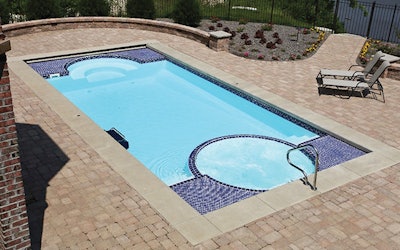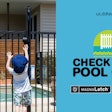
December 19 will mark seven years since the Virginia Graeme Baker Pool and Spa Safety Act — the most significant government regulation impacting the industry this century — was implemented. It's been a rocky road to compliance.
The bill was met with considerable confusion and reluctance on the part of cash-strapped pool operators. The biggest gaff came in May 2011 when the Consumer Product Safety Commission, the agency in charge of VGB, audited all test lab reports, and found some third party laboratories did not conduct the body block test according to the standard, resulting in a voluntary drain cover recall from eight manufacturers.
Despite the recall and lingering controversy surrounding the legislation, the CPSC reports that since VGB has been in effect, there has not been an entrapment accident on a pool or spa that is 100 percent VBG compliant. Put another way, of all the suction entrapment incidents in the U.S. since 2008, all have occurred in pools or spas that were in one way or another did not meet the VGB edicts.
The standard, for better or worse, does seem to have worked, at least so far.
TO DRAIN OR NOT TO DRAIN
The apparent success of VGB has not put an end to criticism of the law, and for some, there remain points of confusion if not outright derision. For many, the very presence of the law has continued to beg a fundamental question — if they're unnecessary for pool circulation, why have bottom drains at all?
That's Kirk Sullivan's position. Sullivan is the president of fiberglass pool manufacturer San Juan Pools, and for the past two years, he has made his company's products available without drains. "If we accept the fact that bottom drains are potential killers, doesn't it make sense to eliminate them altogether?" he says. "That's why I personally believe they should be outlawed."
It's more than just a matter of eliminating main drain entrapment risk. Sullivan points to what he sees as serious problems with VGB, particularly the requirements for drain cover replacement.
"Who has the responsibility for notifying the consumer their covers are about to expire?" he says. "Is it the homeowner's responsibility? What if they sell the property — are they required to pass on the information about the drain cover onto the new owners? What if the installer goes out of business before the seven years is up? What if the homeowner has a pool service company taking care of the pool? Does the service technician have the responsibility to figure out when the covers should be replaced? "No one maintains a database of where and when covers were installed," he adds, "not the manufacturer, not the government or any of our trade associations. I believe no one wants to maintain that kind of data because no one wants the responsibility for notifying the homeowner their covers need to be replaced."
A BRIGHTER VIEW
Not everyone who supports drainless pools holds as dim a view of the industry's ability to comply with the law. Steve Barnes, director of science and compliance for AquaStar, a manufacturer of drain covers, believes there is merit in the no-drain concept. At the same time, he believes VGB has improved industry standards to the point where compliance results in virtually no risk.
"Of course there's always going to be room for improvement," Barnes says, "but if you look at the covers being made since 2008, there's no question they are far more robust and safe than anything made before then. If they're sized and installed properly, there's very little risk. We've come to the point where dealers and homeowners can be confident in the covers that are in distribution, being sold and being installed."
While Barnes has confidence in the VGB standard, particularly the requirements for cover engineering and design, he also shares Sullivan's concern about keeping track of when covers need to be replaced. "We should develop some type of sticker that can be placed by the circuit breaker or somewhere on the equipment pad, something that can be easily checked to determine when the cover should be replaced.
"But," he adds, "this is not an insurmountable problem. I look at suction entrapment and other risks associated with pools much like you would electrical safety. We have electrical outlets all around us, and each could be a potential hazard. But we have standard practices that remove the risk, standards for engineering, manufacturing and installation. It's so common we don't give it another thought. We need to adopt the same mentality when it comes to pool safety. We have the products and the standards in place we need to make and install safe drains that pose virtually no risk.
"It's just something that has to be managed," he adds, "and doing so is well within our ability through awareness, education and proper installation and maintenance. The permanent challenge is the human factor, people make mistakes, like not reading and following the installation instructions."
That said, Barnes does agree that removing bottom suction outlets is a viable alternative. "That is the only option that completely removes human error from the suction safety equation, and I'm a huge fan of surface suction," he says. "Think about it: everything that enters a pool first hits the surface and with the exception of a rock your neighbor's kid throws into the pool, everything is going to float on the surface for a while before it sinks. That's why with adequate skimming action you can maintain desirable water quality conditions.
"And that should be our top priority," he adds. "We need to always be asking ourselves, what it's going to be like to live with this pool or spa? If we can create pools that function cleanly and efficiently, and are easily maintain without bottom drains, then we should be all for it."
For his part, Sullivan sees potential ancillary advantages for dealers who decide to go drainless. "Not having to install a drain eliminates a number of jobsite challenges," he says, "but you also then have an opportunity to sell an automatic cleaner, which is going to do a better job of removing debris than any drain ever would. To my mind, automatic cleaners are essentially roving main drains, and isn't it better to have a roving main drain than a static one?"
NOT SO SIMPLE
While the no-main drain route does have widespread support, designing and installing a pool without a main drain requires more than simply leaving the drain out of the design or disabling an existing one.
One of the big hurdles in drainless pools is determining what happens when the water level drops below the skimmer opening, thus starving the pump of water flow, which will result in cavitation and ultimately the need for a new pump.
That issue is typically addressed with either an automatic fill system or a skimmer equalizer line. Both work, but in the case of the auto fill system, like all mechanical devices, it does require service and will fail if not properly maintained. Equalizer lines do not require maintenance, other than making sure they're not blocked, but they do require an outlet cover just would a bottom suction outlet and are subject to the same VGB requirements.
"Number one is when the skimmers are plugged or when the water level is below the skimmer, where is the pump going to get its water?" Barnes says. "You have to ask yourself, what is the operational plan?"
Another key concern involves preventing damage from hydrostatic pressure. Bottom drain sumps have traditionally been the preferred location for hydrostatic relief valves, which are crucial in preventing damage from ground water when pools are drained for maintenance.
In fiberglass pools without drains, Sullivan explains, groundwater is evacuated from around the shell via sumps, well points and French drains put in place by the original installer. "There are ways around the issue with groundwater," he says, "but you have to be aware that it's a potential problem in the first place."
"It seems so simple, just a hole with a cover on it," says Barnes. "But it's like most things in life, there's just more to it than that."
CASTING AHEAD
Looking forward, both Sullivan and Barnes are optimistic about where the industry is headed on this and other fronts. Sullivan's outlook is bolstered by strong overall sales activity in 2015 and specifically that many of his dealer installers are moving over to the drainless option, which he sees as the best solution to the entrapment issue.
"Eliminating bottom drains not only avoids all the problems with keeping track of drain installation and replacement, but also you can't get stuck on a drain that doesn't exist," he says. "Yes there are some considerations you'll need to address to make it work, but that's easy compared to worrying about what can happen if something goes wrong."
Barnes is also optimistic, especially considering the potential for future innovations. "I really like some of the new slot drain designs," he says. "One of the trends I'm seeing, especially in square spas, is the slot drain that's located in what is the equivalent of a toe kick in a kitchen. The slot drain is recessed behind your heel. There's no way to get at it, you don't have to look at it, and they can move huge amounts of flow. The point being that we're going to see drains continue to evolve."
Comments or thoughts on this article? Please e-mail [email protected].




































